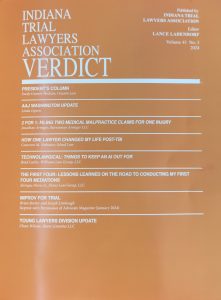- Free Consultation: (844) 268-7775 Tap Here to Call Us
Indiana Trial Lawyers Association (ITLA) Publishes Attorney Jonathan Armiger’s Medical Malpractice Article in VERDICT
2 for 1: Filing Two Medical Malpractice Claims for One Injury

Jonathan Armiger, Barsumian Armiger LLC
Medical malpractice attorneys must sometimes confront the question: To what extent can one pursue separate claims for medical malpractice when there is only one resulting injury? Another question is why one would want to. In considering both questions, one must keep in mind the “all too familiar” but maybe “all too forgotten” doctrines of claim preclusion and issue preclusion.
Davidson v. State
The Indiana Supreme Court did not mince words in the recent case of Davidson v. State, 211 N.E.3d 914 (Ind. 2023), reh’g denied (Sept. 6, 2023), when it found, in a non-medical malpractice context, that issue preclusion barred a separate lawsuit for the same injury, advising “a plaintiff seeking tort damages from both government and non-government defendants must sue all such tortfeasors in one lawsuit.” Id. at 919.
In Davidson, the plaintiff obtained a $3.2 million judgment after a bench trial against a trucking company whose driver fell asleep and crashed his semi-truck into an overpass bridge pier in a construction zone, expelling the plaintiff passenger and rendering her a quadriplegic. Id. at 919-920. The plaintiff then filed a separate lawsuit against the State/INDOT and other private defendants for failing to plan and set up the construction zone so as to prevent or lessen any impact. Id. at 920. While Indiana’s Comparative Fault Act explicitly does not apply to “tort claims” against the government, Ind. Code § 34-51-2-2, the Davidson Court nonetheless found that the Comparative Fault Act does apply to “actions” against the government, as the Comparative Fault Act, with limited exceptions, “governs any action based on fault brought to recover damages for injury or death to a person or harm to property,” Ind. Code § 34-51-2-1, and factfinders “shall consider the fault of all persons who caused or contributed to cause the alleged injury,” Ind. Code § 34-51-2-7(b)(1), 34-51-2-8(b)(1). Davidson, 211 N.E.3d at 923. Because the State/INDOT was not named as a party or non-party in the first lawsuit, the Court found the trial court’s judgment against the trucking company necessarily apportioned 100% fault to it, and therefore, issue preclusion prevented relitigating fault for plaintiff’s injuries in the second lawsuit. Id. at 921-922.
Davidson addressed challenges based on both claim preclusion and issue preclusion. The Supreme Court in Davidsonrejected the trial court’s finding that claim preclusion barred the plaintiff’s claims. Claim preclusion requires four elements: (1) the former judgment was decided by a court of competent jurisdiction, (2) the former judgment was decided on the merits, (3) the matter at issue in the present case was or might have been determined in the prior case, and (4) the prior case was between the same parties in the present case or their privies. Id. at 921. The last claim preclusion element—a prior action between the same parties or their privies—was not applicable in Davidson. Id.
Issue preclusion, on the other hand, prevents a party or its privy from relitigating in a subsequent lawsuit the same fact or issue necessarily decided by a court of competent jurisdiction in a prior lawsuit. Id. Notably, the Court retained the requirement that the party against whom issue preclusion is asserted must have lost on the issue, with courts to consider whether the party against whom issue preclusion is asserted had a full and fair opportunity to litigate the issue in the prior suit, as well as whether it would be unfair under the circumstances for issue preclusion to be used. Id. at 923-924. In Davidson, the Court reasoned the plaintiff “really did lose” in the first lawsuit because she lost on the issue of whether to assign any fault to persons not included as parties or nonparties. Id. at 923.
Davidson and Medical Malpractice Claims
So, what does Davidson have to do with medical malpractice claims? Unlike the “actions” versus “tort claims” distinction applicable to government defendants that the Court analyzed in Davidson, the Comparative Fault Act does not apply to an “action” against a qualified healthcare provider under the Medical Malpractice Act. Ind. Code § 34-51-2-1(b). Of course, inconsistently, the Comparative Fault Act then includes a section that “applies to a claim filed” under the Medical Malpractice Act with regards to the pleading of a nonparty defense. Ind. Code § 34-51-2-17; see also Palmer v. Comprehensive Neurologic Servs., P.C., 864 N.E.2d 1093, 1099 (Ind. Ct. App. 2007) (recognizing the seemingly inconsistent provisions of the Comparative Fault Act and affirming that comparative fault does not apply to medical malpractice actions). The Comparative Fault Act also specifically provides for reasonable delays in actions brought against non-qualified defendants in cases involving qualified and non-qualified defendants, upon application of the claimant, as well as the joinder of qualified defendants after the panel process. Ind. Code § 34-51-2-18. In any event, in cases in which there is a claim subject to the Comparative Fault Act, as noted by the Court in Davidson, “the Act applies to require the jury to apportion a percentage of fault and damages to all defendants and nonparties.” Davidson, 211 N.E.3d at 923-924. There are limits, however, to such apportioning in the context of subsequent malpractice in the treatment of an injury, where a defendant cannot assert a nonparty defense. Edwards v. Sisler, 691 N.E.2d 1252, 1254-1255 (finding the Comparative Fault Act did not change Indiana’s long-standing rule that a tortfeasor is responsible for subsequent malpractice in the treatment of an injury); see also Infectious Disease of Indianapolis, P.S.C. v. Toney, 813 N.E.2d 1223, 1230 (Ind. Ct. App. 2004), opinion amended on reh’g, 828 N.E.2d 386 (Ind. Ct. App. 2005) (recognizing the responsibility for subsequent malpractice also applies when the original tortfeasor is a healthcare provider).
While comparative fault does not apply to actions against qualified defendants under the Medical Malpractice Act, given the Court’s distinction in Davidson between “actions” and “tort claims,” the extent to which issue preclusion is implicated in a fault apportionment against a non-qualified defendant is certainly a consideration to keep in mind in prosecuting claims. As noted by Justice Goff in his concurrence in Davidson, the interplay between Indiana’s common-law and comparative-fault negligence schemes is a “vexingly complicated area,” cautioning against “hard and fast rule[s] of procedure in mixed-theory cases.” Davidson, 211 N.E.3d at 927. However, the analysis is somewhat lessened in straight-up malpractice cases with all qualified defendants.
Prosecuting Two Separate Medical Malpractice Claims for One Injury
As to claims against qualified health care providers under the Medical Malpractice Act, there is no prohibition against prosecuting two separate claims. There may actually be compelling reasons to do so in some cases, particularly while the claims are going through the medical review panel process. Having been excluded from coverage under the Comparative Fault Act, Ind. Code § 34-51-2-1(b), qualified provider defendants under the Medical Malpractice Act are subject to joint and several liability, pursuant to which a plaintiff has the option of suing any or all of the tortfeasors, who are each responsible for the entire amount of damages caused by their negligence without regard to apportionment of fault. Indiana Dep’t of Ins. v. Everhart, 960 N.E.2d 129, 137-38 (Ind. 2012); see also Batchelder v. Indiana Univ. Health Care Associates, Inc., 148 N.E.3d 1116, 1119 (Ind. Ct. App. 2020); Palmer, 864 N.E.2d at 1099. Under historic common law joint and several liability, “[a]n action for personal injuries is joint and several, and one who has received an injury from a wrongful act or omission of two or more persons acting together or independently causing a single injury may enforce his remedy against all jointly or against any one separately.” Kniola v. Kozlowski, 129 N.E. 489, 489 (Ind. Ct. App. 1921). The general rule of joint and several liability provides that “when the torts of two or more persons unite to produce an injury, such injury is indivisible and the person wronged has his remedy against one or all of the tortfeasors in a single or separate actions.” Kizer v. Hazelett, 49 N.E.2d 543, 544 (Ind. 1943). Under the common law, “a person injured by joint tort-feasors may maintain separate suits against each person….” Smith v. Graves, 108 N.E. 168, 170 (Ind. Ct. App. 1915).
Of course, by filing two separate medical malpractice claims for one injury, a plaintiff cannot obtain more than “one satisfaction” for the damages caused. See, e.g., Batchelder, 148 N.E.3d at 1120 (discussing the “one satisfaction rule” whereby payment of the full amount of an injured party’s damages determined by judgment constitutes a satisfaction of a plaintiff’s rights against any other obligor responsible for the indivisible injury); see also Infectious Disease of Indianapolis, P.S.C., 813 N.E.2d at 1231 (finding issue preclusion barred patient from seeking a second recovery from another medical provider after having received the full measure of damages); Westfield Gas & Milling Co. v. Abernathey, 35 N.E. 399, 400-01 (Ind. Ct. App. 1893) (recognizing at common law that while a plaintiff can pursue separate actions under joint and several liability, the plaintiff can have but one satisfaction). Under the Medical Malpractice Act, “a patient who suffers only one compensable injury, regardless of the number of negligent acts causing that injury, is entitled to only one maximum statutory recovery.” Med. Assur. of Indiana v. McCarty, 808 N.E.2d 737, 745 (Ind. Ct. App. 2004). However, the “one satisfaction rule” does not affect a plaintiff’s ability to pursue separate claims, at least not until receiving full satisfaction. See Batchelder, 148 N.E.3d at 1123-1124; see also Infectious Disease of Indianapolis, P.S.C., 828 N.E.2d at 387-388 (recognizing the principle of satisfaction precludes the continuation of a lawsuit when full damages have already been received).
Contrary to what opponents of separate claims and separate panels may argue, there is nothing in the Medical Malpractice Act or in the Indiana Rules of Trial Procedure that prohibits such an approach. In fact, pursuing separate claims for medical malpractice when there is only one resulting injury comports with the Medical Malpractice Act. The Medical Malpractice Act provides, for instance, that if there is only one party-defendant who is an individual and who specializes in a limited area, two of the medical review panelists selected must also specialize in the same area as the defendant. Ind. Code § 34-18-10-8. In cases with multiple different defendants with multiple specialties providing care at different times, it can be beneficial to have separate medical review panels. Having only a single panel review a case in which there are more than three specialties results in a panel composition that does not include all the relevant specialties. The Medical Malpractice Act evidences the legislature’s intent for medical review panels to consist of similarly specialized physicians, which makes common sense given the scope of review.
While some defendants may continue to seek court intervention for a preliminary determination with regards to separately filed claims, Indiana law is clear that “medical review panels should be allowed to operate in [an] informal manner,” and “the grant of power to the trial court to preliminarily determine matters is to be narrowly construed.” Griffith v. Jones, 602 N.E.2d 107, 110-111 (Ind. 1992). For instance, joint and several liability, by definition, renders joinder of an indispensable party under Indiana Trial Rule 19(A) inapplicable, with Trial Rule 19(E) even providing that “[j]oinder of all the parties to a joint and several obligation… shall not be required, and [a] joint or separate action may be brought….” Ind. R. Trial P. 19(E). To be sure, medical malpractice claimants can proceed with separate claims to have separate panels comprised of experts relevant to the separate claims.
Conclusion
Certainly, in light of Davidson, plaintiffs should be very cautious in attempting to prosecute separate lawsuits for the same injuries if one claim is subject to the Comparative Fault Act (e.g., a claim against a non-qualified provider), given the mandatory fault apportioning under the Comparative Fault Act. However, in the context of straight-up medical malpractice cases, filing separate claims remains a viable and sometimes beneficial approach, particularly while the claims are pending before a medical review panel. Of course, “the devil is in the details,” and plaintiffs should remain mindful of the potential pitfalls of claim and issue preclusion.
Jonathan Armiger is a member of Barsumian Armiger LLC. He graduated cum laude from the Indiana University Maurer School of Law in 2011. He is licensed to practice law in Indiana and represents individuals and families in personal injury and medical malpractice cases.
Republished with permission of ITLA.














